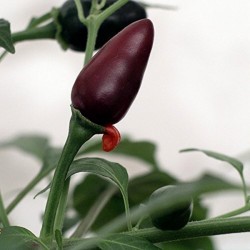Menu
-
MenuWstecz
- Home
-
Kategorie
-
-
Kategorie
-
Nasiona warzyw
-
Odmiany według kraju
- Odmiany z Armenii
- Odmiany z BiH
- Odmiany z Chorwacji
- Odmiany z Francji
- Varieties from Germany
- Varieties from Greece
- Varieties from Hungary
- Odmiany z Indii
- Varieties from Italy
- Odmiany z Japonii
- Odmiany z North Macedonii
- Varieties from Peru
- Varieties from Russia
- Varieties from Serbia
- Odmiany ze Słowenii
- Varieties from Spain
- Varieties from Thailand
- Odmiany z Turcji
- Varieties from USA
- Nasiona Pomidorów
- Nasiona kukurydzy
- Gurda rodziny
- Rodzina fasoli
- Nasiona Ogórka
- Nasiona Papryki
- Rodzina marchwi
- Rodzina cebuli
- Nasiona Sałaty
- Rodzina ziemniaków
- Rodzina kapuściana
- Nasiona Rzodkiewki
- Rodzina buraków
- Nasiona arbuza
- Nasiona melona
- Nasiona kalafiora
- Rodzina słoneczników
-
Odmiany według kraju
- Nasiona Owoców
- Nasiona Papryki Chili
- Nasiona ziół leczniczych
- Nasiona roślin pnących
- Drzewa - Krzewy - Nasiona
- Nasiona palmy
- Nasiona Traw Ozdobnych
- Nasiona tytoniu
-
Nasiona warzyw
-
-
-
-
- NOWE PRODUKTY
- Dostawa - płatność
- Utwórz konto
- FAQ
Lista produktów marki Seeds Gallery
Seeds produced by Seeds Gallery
Seeds produced by Seeds Gallery
Jest 408 produktów.
Pokazano 277-288 z 408 pozycji
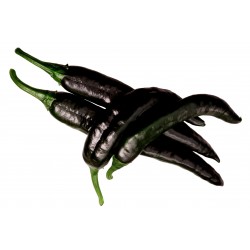
Pasilla Bajio Seeds - Black...
Cena
1,95 €
SKU: C 30
Seeds Gallery Com,
5/
5
<!DOCTYPE html>
<html>
<head>
<meta http-equiv="Content-Type" content="text/html; charset=UTF-8" />
</head>
<body>
<h2><em><span style="text-decoration: underline;"><strong>Pasilla Bajio Seeds - Black Chili</strong></span></em></h2>
<h3><em></em><span style="color: #ff0000;"><strong>Price for Package of 10 seeds.<br /></strong></span></h3>
<div>80 days. Pasilla means 'little raisin' in Spanish, referring to the wrinkled, deep brown dried pods and raisin-like aroma of this flavourful chile no good cook should be without. The elongated, cylindrical pods measure 6 to 8 inches long and an inch wide. Delicious either fresh or dried, at the immature stage the beautiful fruits are a remarkable, glossy, deep forest-green colour that matures to dark chocolate brown. The TMV resistant plants grow 2 to 3 feet tall, with branches beginning 5 to 6 inches from the low stem so pods don't touch the ground. The dried pods of this delicious pepper form the basis for the rich complex flavour of Mole sauces where no heat is required. Heat level is 0.5 (Capsicum annuum)</div>
</body>
</html>
C 30

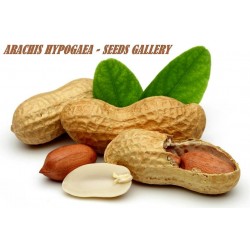
Peanut Seeds (Arachis...
Cena
1,95 €
SKU: VE 214 W
Seeds Gallery Com,
5/
5
<h2 class=""><strong>Peanut Seeds (Arachis Hypogaea)</strong></h2>
<h2 class=""><span style="color: #ff0000;"><strong>Price for Package of 10 (7g), 20 (14g) seeds.</strong></span></h2>
<div>The peanut, or groundnut (Arachis hypogaea), is a species in the legume or "bean" family (Fabaceae). The peanut was probably first domesticated and cultivated in the valleys of Paraguay.[1] It is an annual herbaceous plant growing 30 to 50 cm (1.0 to 1.6 ft) tall. The leaves are opposite, pinnate with four leaflets (two opposite pairs; no terminal leaflet), each leaflet is 1 to 7 cm (⅜ to 2¾ in) long and 1 to 3 cm (⅜ to 1 inch) broad.</div>
<p>The flowers are a typical peaflower in shape, 2 to 4 cm (0.8 to 1.6 in) (¾ to 1½ in) across, yellow with reddish veining. Hypogaea means "under the earth"; after pollination, the flower stalk elongates causing it to bend until the ovary touches the ground. Continued stalk growth then pushes the ovary underground where the mature fruit develops into a legume pod, the peanut – a classical example of geocarpy. Pods are 3 to 7 cm (1.2 to 2.8 in) long, containing 1 to 4 seeds.[2]</p>
<p>Peanuts are known by many other local names such as earthnuts, ground nuts, goober peas, monkey nuts, pygmy nuts and pig nuts.[3] Despite its name and appearance, the peanut is not a nut, but rather a legume.</p>
<p><strong>Cultivation</strong></p>
<p>The orange-veined, yellow-petaled, pea-like flower of the Arachis hypogaea is borne in axillary clusters above ground. Following self-pollination, the flowers fade and wither. The stalk at the base of the ovary, called the pedicel, elongates rapidly, and turns downward to bury the fruits several inches in the ground, where they complete their development. The entire plant, including most of the roots, is removed from the soil during harvesting.[8] The fruits have wrinkled shells that are constricted between pairs of the one to four (usually two) seeds per pod.</p>
<p>Peanuts grow best in light, sandy loam soil. They require five months of warm weather, and an annual rainfall of 500 to 1,000 mm (20 to 39 in) or the equivalent in irrigation water.[9]</p>
<p>The pods ripen 120 to 150 days after the seeds are planted. If the crop is harvested too early, the pods will be unripe. If they are harvested late, the pods will snap off at the stalk, and will remain in the soil.[8] They need an acidic soil to grow preferably with 5.9-7 pH.</p>
<p>Peanuts are particularly susceptible to contamination during growth and storage. Poor storage of peanuts can lead to an infection by the mold fungus Aspergillus flavus, releasing the toxic and highly carcinogenic substance aflatoxin. The aflatoxin-producing molds exist throughout the peanut growing areas and may produce aflatoxin in peanuts when conditions are favorable to fungal growth.</p>
<p>Harvesting occurs in two stages[citation needed]: In mechanized systems, a machine is used to cut off the main root of the peanut plant by cutting through the soil just below the level of the peanut pods. The machine lifts the "bush" from the ground and shakes it, then inverts the bush, leaving the plant upside down on the ground to keep the peanuts out of the soil. This allows the peanuts to dry slowly to a bit less than a third of their original moisture level over a period of three to four days. Traditionally, peanuts were pulled and inverted by hand.</p>
<p>After the peanuts have dried sufficiently, they are threshed, removing the peanut pods from the rest of the bush.</p>
<p><strong>Uses</strong></p>
<p>Peanuts have many uses. They can be eaten raw, used in recipes, made into solvents and oils, medicines, textile materials, and peanut butter, as well as many other uses. Popular confections made from peanuts include salted peanuts, peanut butter (sandwiches, peanut candy bars, peanut butter cookies, and cups), peanut brittle, and shelled nuts (plain/roasted). Salted peanuts are usually roasted in oil and packed in retail-size plastic bags or hermetically sealed cans. Dry roasted salted peanuts are also marketed in significant quantities. Peanuts are often a major ingredient in mixed nuts because of their relative cost compared to Brazil nuts, cashews, walnuts, and so on. Although peanut butter has been a tradition on camping trips and the like because of its high protein content and because it resists spoiling for long periods of time, the primary use of peanut butter is in the home. Large quantities are also used in the commercial manufacture of sandwiches, candy, and bakery products. Boiled peanuts are a preparation of raw, unshelled green peanuts boiled in brine and often eaten as a snack. More recently, fried peanut recipes have emerged – allowing both shell and nut to be eaten. Peanuts are also used in a wide variety of other areas, such as cosmetics, nitroglycerin, plastics, dyes and paints.</p>
<p><strong>Peanut oil</strong></p>
<p>Peanut oil is often used in cooking, because it has a mild flavor and a relatively high smoke point. Due to its high monounsaturated content, it is considered more healthy than saturated oils, and is resistant to rancidity. There are several types of peanut oil including: aromatic roasted peanut oil, refined peanut oil, extra virgin or cold pressed peanut oil and peanut extract. In the United States, refined peanut oil is exempt from allergen labeling laws.[12]</p>
<p><strong>Peanut flour</strong></p>
<p>Peanut flour is lower in fat than peanut butter, and is popular with chefs because its high protein content makes it suitable as a flavor enhancer[citation needed]. Peanut flour is used as a gluten-free solution.</p>
<p><strong>Boiled peanuts</strong></p>
<p>Boiled peanuts are a popular snack in the southern United States, as well as in India, China and West Africa.</p>
<p><strong>Dry roasted peanuts</strong></p>
<p>Dry peanuts can be roasted in the shell in a home oven if spread out one layer deep in a pan and baked at a temperature of 350°F or 177°C for 18–20 minutes.</p>
<p><strong>Cuisine</strong></p>
<p><strong>South America</strong></p>
<p>Peanuts are used in many sauces for South American meat dishes, especially rabbit. Peanuts are common in Peruvian cuisine, which marries native and European ingredients. For instance, roasted peanuts and hot peppers, both native to South America, appear with roasted onions, garlic, and oil—all of European origin—in a smooth sauce poured over boiled potatoes, a dish well known in the city Arequipa and called papas con ocopa. Another example is a fricassee combining a similar mixture with sautéed seafood or boiled and shredded chicken. These dishes are generally known as ajíes, meaning "hot peppers", such as ají de pollo and ají de mariscos. (Seafood ajíes may omit peanuts.)</p>
<p>Likewise, during Colonial times, the Spanish in Peru used peanuts to replace nuts unavailable in Peru but used extensively in Spanish cuisine, such as almonds, pine nuts, and other nuts, typically ground or as paste and mixed with rice, meats, and vegetables for dishes such as rice pilaf.</p>
<p><strong>Southwest Asia</strong></p>
<p>Crunchy coated peanuts, called kabukim in Hebrew, are a popular snack in Israel. Kabukim are commonly sold by weight at corner stores where fresh nuts and seeds are sold, though they are also available packaged. The coating typically consists of flour, salt, starch, lecithin, and sometimes sesame seeds. The origin of the name is obscure.(It may be derived from kabuk which means nutshell or husk in Turkish.) An additional variety of crunchy coated peanuts popular in Israel is "American peanuts". The coating of this variety is thinner, but harder to crack.</p>
<p>Another popular Israeli peanut snack, Bamba puffs, is similar in shape to Cheez Doodles, but are made of corn and flavored with peanut butter.</p>
<p>Southeast Asia</p>
<p>Peanuts are also widely used in Southeast Asian cuisine, particularly Indonesia, where they are typically made into a spicy sauce. Peanuts originally came to Indonesia from the Philippines, where the legume came from Mexico in times of Spanish colonization.</p>
<p>Common Indonesian peanut-based dishes include gado-gado, pecel, karedok and ketoprak, all vegetable salads mixed with peanut sauce, and the peanut-based sauce for satay.</p>
<p>In the Indian subcontinent, peanuts are known as a light snack by themselves, usually roasted and salted (sometimes with the addition of chilli powder), and often sold roasted in pod, or boiled with salt. They are also made into little dessert or sweet snack pieces by processing with refined sugar and jaggery. Indian cuisine uses roasted, crushed peanuts to give a crunchy body to salads; they are added whole (without pods) to leafy vegetable stews for the same reason. Another use of peanut oil as cooking oil. Most Indians use mustard, sunflower, and peanut oil for cooking. Peanuts are not native to India. They are thought to have come to India from Philippines. Notably, the name of this nut in northern parts of Tamil Nadu is 'மணிலாக் கொட்டை'- slang மல்லாக் கொட்டை- (Manila-k-kottai) means nut from Manila, the capital city of Philippines.</p>
<p>West Africa</p>
<p>Peanuts grow well in southern Mali and adjacent regions of the Ivory Coast, Burkina Faso, Ghana, Nigeria and Senegal; peanuts are similar in both agricultural and culinary qualities to the Bambara groundnut native to the region, and West Africans have adopted the crop as a staple. Peanut sauce, prepared with onions, garlic, peanut butter/paste, and vegetables such as carrots, cabbage, and cauliflower, can be vegetarian (the peanuts supplying ample protein) or prepared with meat, usually chicken.</p>
<p>Peanuts are used in the Mali meat stew maafe. In Ghana, peanut butter is used for peanut butter soup nkate nkwan.[13] Crushed peanuts may also be used for peanut candies nkate cake and kuli-kuli, as well as other local foods such as oto.[13] Peanut butter is also an ingredient in Nigeria's "African salad".</p>
<p>Peanut powder is an important ingredient in the spicy coating for kebabs in Nigeria and Ghana.</p>
<p><strong>East Africa</strong></p>
<p>Peanuts are a common ingredient of several types of relishes (dishes which accompany nshima) eaten by the tribes in Malawi and in the eastern part of Zambia, and these dishes are now common throughout both countries. Thick peanut butter sauces are also made in Uganda to go with rice and other starchy foods. Across East Africa, roasted peanuts (often in cones of newspaper) are a popular snack sold in the street.</p>
<p><strong>North America</strong></p>
<p>In the US, peanuts are used in candies, cakes, cookies, and other sweets. They are also enjoyed roasted and salted. Peanut butter is one of the most popular peanut-based foods in the US, and for four hundred years, recipes for peanut soup have been present in the South, Virginia in particular. In some southern portions of the US, peanuts are boiled for several hours until soft and moist. Peanuts are also deep-fried, shell and all.</p>
<p><strong>Malnutrition</strong></p>
<p>Peanuts are used to help fight malnutrition. Plumpy Nut, MANA Nutrition,[14] and Medika Mamba[15] are high-protein, high-energy and high-nutrient peanut-based pastes developed to be used as a therapeutic food to aid in famine relief. The World Health Organization, UNICEF, Project Peanut Butter and Doctors Without Borders have used these products to help save malnourished children in developing countries.</p>
<p><strong>Other uses</strong></p>
<p>Peanuts can be used like other legumes and grains to make a lactose-free milk-like beverage, peanut milk. Peanut plant tops are used for hay.</p>
<p>Low-grade or culled peanuts not suitable for the edible market are used in the production of peanut oil for manufacturing.[citation needed] The protein cake (oilcake meal) residue from oil processing is used as an animal feed and as a soil fertilizer. Low-grade peanuts are also widely sold as a garden bird feed.</p>
<p>Peanuts have a variety of industrial end uses. Paint, varnish, lubricating oil, leather dressings, furniture polish, insecticides, and nitroglycerin are made from peanut oil. Soap is made from saponified oil, and many cosmetics contain peanut oil and its derivatives. The protein portion is used in the manufacture of some textile fibers. Peanut shells are used in the manufacture of plastic, wallboard, abrasives, fuel, cellulose (used in rayon and paper) and mucilage (glue). Rudolf Diesel ran some of the first engines that bear his name on peanut oil[16] and it is still seen as a potentially useful fuel.</p>
<p>Plant Common Name: Peanut seeds</p>
<p>Plant Genus/Species Name: Arachis hypogaea</p>
<p>Sowing Temperature: 16 - 26 Celcius</p>
<p>Growing Temperature: 8 - 38 Celcius</p>
<p>Days to Maturity: 60-80 Days</p>
<p><span style="color: #008000;"><strong>How to Sow Peanut</strong></span></p>
<p>Peanuts need a long, hot growing season to fully mature. Do not plant in areas that do not have at least 4-5 months of frost-free weather. Shell the seeds before sowing. In loose, well-drained soil in a sunny location, sow seeds directly outdoors after the last frost. Plant in light, deeply dug and prepared alkaline soil. Create a furrow 2" deep and sow seeds 4-6" apart, being careful not to damage the tender seeds. Space rows 3' apart. Seeds germinate in 10-15 days.</p>
<script src="//cdn.public.n1ed.com/G3OMDFLT/widgets.js"></script>
VE 214 W (7g)


Penis Chili Seeds
Cena
3,00 €
SKU: C 9
Seeds Gallery Com,
5/
5
<h2><strong>Penis Chili Seeds (Peter Pepper)</strong></h2>
<h2 class=""><span style="color: #fe0000;"><strong>Price for Package of 5 seeds.</strong></span></h2>
<div>Definitely not for the prudish. The Peter Pepper is named for its similarity in appearance to an anatomical part. This definitely is a pepper that gets people talking. Plants grow to about 2 feet in height. Medium hot to hot with a good taste. Green fruit ripening to yellow. Can be eaten fresh or dried for seasoning and making chili powder.</div><script src="//cdn.public.n1ed.com/G3OMDFLT/widgets.js"></script>
C 9 R


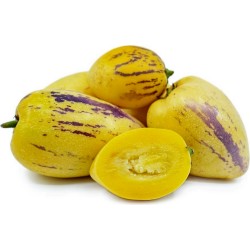
Pepino Dulce, Melon Pear...
Cena
2,95 €
SKU: V 59
Seeds Gallery Com,
5/
5
<h2><span style="font-size: 14pt;" class=""><strong>Pepino Dulce, Melon Pear Seeds (Solanum muricatum)</strong></span></h2>
<h3><span style="color: #ff0000; font-size: 14pt;"><strong>Price for Package of 5 seeds.</strong></span></h3>
<p>Solanum muricatum is a species of evergreen shrub native to South America and grown for its sweet edible fruit.</p>
<p>It is known as pepino dulce ("sweet pepino") or simply pepino; the latter is also used for similar species such as "S. mucronatum" (which actually seems to belong in the related genus Lycianthes). The pepino dulce fruit resembles a melon (Cucumis melo) in color, and its flavor recalls a succulent mixture of honeydew and cucumber, and thus it is also sometimes called pepino melon or melon pear, but pepinos are only very distantly related to melons and pears. Another common name, "tree melon", is more often used for the Papaya (Carica papaya) and the pepino dulce plant does generally not look much like a tree. The present species is, however, a close relative of other nightshades cultivated for their fruit, including the tomato (S. lycopersicum) and the eggplant (S. melongena), which its own fruit closely resembles.</p>
<p>The fruit is common in markets in Colombia, Ecuador, Bolivia, Peru and Chile, but less often overseas because it is quite sensitive to handling and does not travel well. Attempts to produce commercial cultivars and to export the fruit have been made in New Zealand, Turkey and Chile.</p>
<p><strong>Distribution and habitat</strong></p>
<p>The pepino dulce is presumed to be native to the temperate Andean regions of Colombia, Peru and Chile, though it is not known in the wild and the details of its domestication are unknown.Thepepino is a domesticated native of the Andes.</p>
<p><strong>Cultivation</strong></p>
<p>Moche clay vessel with pepino decoration (Larco Museum)</p>
<p>Pepinos are not often found archaeologically as they are soft and pulpy and not easy to preserve, while their tough seeds are small and easily lost among debris. But they were already described by early Spanish chroniclers as being cultivated on the coast; the Moche Valley in Peru was particularly famous for them. They were a popular decorative motif in Moche art.</p>
<p>In the United States the fruit is known to have been grown in San Diego before 1889 and in Santa Barbara by 1897. More commercially viable cultivars were introduced from New Zealand and elsewhere towards the end of the 20th century, leading to its introduction into up-scale markets in Japan, Europe and North America.</p>
<p>The pepino dulce is relatively hardy. In its native range it grows at altitudes ranging from close to sea level up to 3,000 m (10,000 ft.). However, it performs best in a warm, relatively frost-free climate. The plant can survive a low temperature of -2.5°C (27 to 28°F) if the freeze is not prolonged, though it may drop many of its leaves.[2] The species is a perennial, but its sensitivity to chilling, pests, and diseases force the growers to replant the crop every year. The crop also adapts well to greenhouse cultivation, training the plants up to 2 m tall, and obtaining yields that are 2-3 times larger than those obtained outdoors.</p>
<p>They are propagated by cuttings since they are established easily without rooting hormones. It is grown in a manner similar to its relatives such as the tomato, though it grows naturally upright by habit and can thus be cultivated as a free-standing bush, though it is sometimes pruned on trellises. Additionally, supports are sometimes used to keep the weight of the fruit from pulling the plant down. It has a fast growth rate and bears fruit within 4 to 6 months after planting. It is a perennial, but is usually cultivated as an annual. Seedlings are intolerant of weeds, but it can later easily compete with low growing weeds. Like their relatives tomatoes, eggplants, tomatillos and tamarillos, pepinos are extremely attractive to beetles, aphids, white flies and spider mites. Pepinos are tolerant of most soil types, but require constant moisture for good fruit production. Established bushes show some tolerance to drought stress, but this typically affects yield. The plants are parthenocarpic, meaning it needs no pollination to set fruit, though pollination will encourage fruiting.</p>
<p><strong>Ripe pepinos</strong></p>
<p>The plant is grown primarily in Chile, New Zealand and Western Australia. In Chile, more than 400 hectares are planted in the Longotoma Valley with an increasing proportion of the harvest being exported. Colombia, Peru, and Ecuador also grow the plant, but on a more local scale. Outside of the Andean region, it been grown in various countries of Central America, Morocco, Spain, Israel, and the highlands of Kenya. In the United States several hundred hectares of the fruit are grown on a small scale in Hawaii and California. More commercially viable cultivars have been introduced from New Zealand and elsewhere in more recent times. As a result, the fruit has been introduced into up-scale markets in Japan, Europe and North America and it is slowly becoming less obscure outside of South America. Delicate and mild-flavored, pepinos are often eaten as a fresh snack fruit, though they combine very well with a number of other fruits as well.</p>
<p>The study of the molecular variation of this pepino is of interest for several reasons. Although the seeds of pepino plants are fertile and produce vigorous offspring, this crop is primarily propagated by cuttings (Heiser, 1964; Anderson, 1979; Morley-Bunker, 1983), and as a consequence, its genetic structure could be different from that of seed-propagated crops.</p>
<script src="//cdn.public.n1ed.com/G3OMDFLT/widgets.js"></script>
V 59 5S


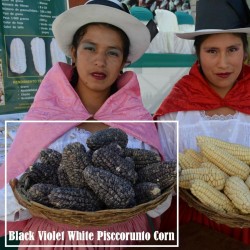
Peruvian B-V-W Giant Corn...
Cena
2,45 €
SKU: P 281
Seeds Gallery Com,
5/
5
<!DOCTYPE html>
<html>
<head>
<meta http-equiv="Content-Type" content="text/html; charset=UTF-8" />
</head>
<body>
<h2><strong>Peruvian Black Violet White Giant Corn Seeds "K'uyu Chuspi"</strong></h2>
<h2><span style="color: #ff0000;"><strong>Price for Package of 10 seeds.</strong></span></h2>
<p>"K'uyu Chuspi" Corn has a softer shell and interior, and for this reason, is most widely used as a toasted (cancha).</p>
<p>This unusual Giant kernel corn is grown for popping. The robust kernels explode when heated Having not enough force to jump out of the pot. Unlike the popcorn that most of us are used to, "K'uyu Chuspi" corn does not “pop” all the way, instead, the heart stays meaty and “puffy” with a nice toasted flavor. Being from the Andes, this is surely another long season corn that is most adapted to short daylengths.</p>
<p>"K'uyu Chuspi" corn is a native variety of Peru and the provinces of Jujuy and Salta, in North-western Argentina. Its spikes are oval to conical in shape, with numerous rows of 18 to 24 kernels each. The grains are long, narrow, containing starch in the heel and dextrin or sugar at the apex and becoming wrinkled when mature. </p>
<p>"K'uyu Chuspi" corn is still produced in its native area by farmers of pre-Hispanic origin, who traditionally use it as a food reserve for the winter. Its roasted grains are eaten as they are or together with goat cheese, another product of the region. In addition, it can also be transformed into a typical breakfast drink. Finally, its green ears, called ‘choclos’, can be occasionally consumed boiled in water or roasted, their taste being sweeter than the mature ones as they feature a higher sugar content.</p>
</body>
</html>
P 281 10-S NS


Peru'dan Çeşitli

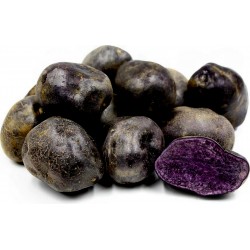
Peruvian Purple Potato Seeds
Cena
2,95 €
SKU: P 441
Seeds Gallery Com,
5/
5
<!DOCTYPE html>
<html>
<head>
<meta http-equiv="Content-Type" content="text/html; charset=UTF-8" />
</head>
<body>
<h2><strong>Peruvian Purple Potatoes Seeds</strong></h2>
<h2><strong><span style="color: #ff0000;">The price is for 5 or 10 purple seed potatoes.</span></strong></h2>
<p>We send it like young and small, so it can be delivered to any Mailbox. It has the taste and texture of an ordinary variety but boasts vivid purple flesh which retains its color during cooking. High in anthocyanin antioxidants, it’s better for you too. Ideal for mashing, baking, roasting and microwaving, as well as making spectacular chips and Pommes Frites!</p>
<p>If you’re a spud lover but stopped eating potatoes due to their reputation of causing weight gain, you may be in luck. Studies show it could be the potato you choose in addition to how the potato is prepared that make a difference. What about french fries? Well, those fries are six times more likely to cause weight gain if enjoyed too often, and besides, the super high temperatures they’re cooked at cause the loss of any possible nutrients, so why bother? And if you think adding all those delicious fatty toppings is the way to go, think again. Instead, opt for purple potatoes.</p>
<p>Purple potatoes are <strong>high-antioxidant foods</strong> that are eye-catching since the skin and the flesh are both purple, making them a beautiful adornment to any plate. But it’s not just the color that’s appealing. Purple potatoes offer a host of awesome benefits from working as a healthy food-coloring agent to helping regulate blood pressure to aiding athletic performance and more.</p>
<p><strong>Benefits of Purple Potatoes</strong></p>
<ol>
<li><strong> Healthy Food-Coloring Alternative</strong></li>
</ol>
<p>Potatoes, carrots and other <strong>root vegetables</strong> are used for coloring foods and grown specifically for the natural colors industry. This is great news since they’re completely natural versus the numerous chemical <strong>food dyes linked to cancer</strong> that have been used for years.</p>
<p>The American Chemical Society documents the research that has been done regarding this food use, noting that the purple sweet potato is chock-full of anthocyanins, which provide health benefits not found in artificial food colors. Purple sweet potato anthocyanins are great for food and beverage coloring and are used in food products, such as fruit drinks, vitamin waters, ice cream and yogurt. What makes them unique goes beyond their color. They’re more stable options because they do not break down easily, making them consistent in providing color while giving little to no taste. (2)</p>
<p>Though it’s difficult to extract, it’s still a better choice given the traditional synthetic versions of colorings and the process of extraction from cochineal insects. In fact, cochineal insects feed on a certain type of cactus native to South America and Mexico, and it takes about 2,500 bugs to produce just one ounce of cochineal extract, which is often used in ice creams, yogurts, candy, beverages and the like.</p>
<ol start="2">
<li><strong> Help Lower and Regulate Blood Pressure</strong></li>
</ol>
<p>A small study presented by the American Chemical Society found that eating purple potatoes may lower blood pressure. This could be because of their effect on the capillaries and blood vessels, along with the high concentration of a phytochemical called chlorogenic acid, which has been linked to lower blood pressure found in some studies. (3) This research shows that plain purple potatoes, baked or cooked in the microwave, lowered the blood pressure of subjects that were reviewed by 3 percent to 4 percent, with no weight gain, and was likely due to the antioxidant behavior and phytonutrient density that these colorful gems exude.</p>
<p>The health benefits are similar to what the popular nutrient-rich providers <strong>broccoli</strong>, spinach and Brussels sprouts provide. And let’s not forget about the potassium they contain, which offers the regulation of blood pressure. (4) This makes purple potatoes and other similar foods excellent additions to any <strong>high blood pressure diet</strong> treatment plan.</p>
<ol start="3">
<li><strong> May Prevent Blood Clots</strong></li>
</ol>
<p><strong>Thrombosis</strong>, a formal name for blood clotting, is a leading cause of death throughout the world but can be prevented, possibly by adding a little purple potato into your diet. As noted previously, the purple potato contains chlorogenic acid. This acid has been shown to break down blood clots and inhibit the enzymatic activity of procoagulant proteins and peptides.</p>
<p>Research published in the <em>Journal of Biochemical and Molecular Toxicology</em>found that chlorogenic acid delayed the development of blood clots in mice, demonstrating the anti-thrombotic effect and making it a potential agent for the treatment of blood clots, including possible prevention.</p>
<ol start="4">
<li><strong> Jam-Packed with Antioxidants and Phytonutrients</strong></li>
</ol>
<p>The purple potato is loaded with antioxidants and disease-fighting <strong>phytonutrients</strong> that work together to offer amazing health benefits, such as reducing inflammation. One of the elements within this powerful cocktail is the anthocyanin, which is what gives the potato its brilliant purple color. But it’s the <strong>free-radical scavenging</strong> and antioxidant capabilities of the anthocyanin pigments that gives the desired health benefits.</p>
<p>Anthocyanin pigments as medicine have been a part of folk medicine for ages and used as remedies for liver dysfunction and hypertension, and much like the <strong>bilberry</strong>, anthocyanins have been linked to helping reduce the risks of eye diseases and infections. (6) </p>
<ol start="5">
<li><strong> Provides Fiber</strong></li>
</ol>
<p>Most people don’t eat enough fiber, according to numerous reports. Maybe a little purple potato can help with that problem since it’s a healthier <strong>high-fiber food</strong>. Why is fiber so important? One of the biggest reasons is it helps keep things moving along smoothly through your digestive system, which can help eliminate constipation, irregularity and discomfort.</p>
<p>Fiber is classified as soluble, which means it dissolves in water, or insoluble, which doesn’t. Potatoes contain the insoluble form as well as whole-wheat flour, wheat bran, nuts, beans, and vegetables, like cauliflower and green beans. Including both soluble and insoluble fiber promotes the best health, and purple potatoes offer a good dose of the insoluble kind to help reach the proper amount of fiber needs. (7) </p>
<ol start="6">
<li><strong> Great for Endurance Athletes and Ultra Runners</strong></li>
</ol>
<p>Another reason that insoluble fiber is so helpful is that it can provide a sort of time-released effect that helps endurance athletes sustain high energy levels for long periods of time. In fact, it’s not unusual to find potatoes at an aid station during a long-distance race.</p>
<p><em>Runner’s World</em> reports that while the ever-so famous carb-loader pasta seems to take front stage, the potato may do a better job, not only the night before but also the day of an event by providing more energy-delivering complex carbohydrates. Not only are they super easy to prepare, but they’re easy to digest — a common concern with most athletes. As well, potassium is useful for athletes of all types, in particular, due to the electrolytes it contains. The purple potato contains 341 milligrams of potassium per half cup serving, which is 10 percent of the daily recommended value. This may make the potato the perfect carb for athletes — and to help prevent <strong>low potassium</strong>. (8)</p>
<p><strong>Purple Potatoes Nutrition</strong></p>
<p>A half cup of diced, raw purple potatoes contains about: (9)</p>
<ul>
<li>52 calories</li>
<li>12 grams carbohydrates</li>
<li>1.4 grams protein</li>
<li>0.1 gram fat</li>
<li>1.3 grams fiber</li>
<li>6.5 milligrams vitamin C (11 percent DV)</li>
<li>341 milligrams potassium (10 percent DV)</li>
<li>0.1 milligrams vitamin B6 (6 percent DV)</li>
<li>45.7 milligrams phosphorus (5 percent DV)</li>
<li>0.1 milligrams copper (5 percent DV)</li>
<li>0.1 milligram manganese (5 percent DV)</li>
<li>0.1 milligram thiamine (4 percent DV)</li>
<li>0.9 milligram niacin (4 percent DV)</li>
<li>16.5 milligrams magnesium (4 percent DV)</li>
</ul>
<p><strong>How to Use Purple Potatoes</strong></p>
<p>Purple potatoes are versatile but can become a little mushy if overcooked. Even though they have a rich, vibrant violet color, their flavor is more subtle than some other potato varieties. Because of this, unlike the <strong>sweet potato</strong> that’s delicious all by itself, the purple potato is usually prepared by adding seasonings. Keep in mind that boiling or baking is the best method versus deep frying, which kills any useful nutrients. Use a little coconut or olive oil with some salt and pepper for a delightful addition to any meal.</p>
<p><strong>Purple Potato Recipes</strong></p>
<p>There are many ways to utilize purple potatoes in recipes. Try this one to start:</p>
<p><strong>Roasted Rosemary Garlic and Turmeric Purple Potatoes with Leeks</strong></p>
<p>INGREDIENTS:</p>
<ul>
<li>2 sprigs fresh rosemary (save one for garnish)</li>
<li>10 small purple potatoes</li>
<li>1 teaspoon sea salt</li>
<li>1 teaspoon pepper</li>
<li>1 teaspoon turmeric</li>
<li>1/4 cup leeks, sliced</li>
<li>2 cloves garlic, minced</li>
<li>2.5 tablespoons coconut oil</li>
</ul>
<p>DIRECTIONS:</p>
<ol>
<li>Preheat oven to 375 degrees.</li>
<li>Slice the leeks and garlic and set aside.</li>
<li>Rinse potatoes and cut in small pieces about a quarter inch thick.</li>
<li>In a bowl, mix the leeks, garlic, turmeric and potatoes with the coconut oil. It may help to melt the coconut oil first.</li>
<li>Add the sea salt, pepper and chopped rosemary, and mix well.</li>
<li>Now place the potatoes to a baking sheet lined with foil.</li>
<li>Roast for 35–45 minutes or until potatoes are soft and begin to brown.</li>
<li>Place a half cup serving as a side dish on a plate, and garnish with a small sprig of rosemary.</li>
</ol>
<p>You can also try Purple Potato Salad with Avocado-Chia Dressing recipe and use purple potatoes in most side dishes that utilize potatoes.</p>
<p><strong>History of Purple Potatoes</strong></p>
<p>The history of the purple potato goes back to what’s known as the purple Peruvian, which is an heirloom fingerling potato. Potatoes, in addition to tomatoes, peppers and eggplants, are part of the <em>Solanaceae</em> or <strong>nightshade vegetables</strong> family. The purple or blue violet potato fits into what has been called vitelotte, though not necessarily violet in color. This violet or purple potato may have been noted as early as 1817, listed as available at the market of Les Halles.</p>
<p>Information published in 1863 listed five possible colors for the vitelotte, which were white, yellow, pink, red and violet. In 1873, Alexandre Dumas, a French author, wrote in his Grand dictionnaire de cuisine that “… the best of all are unquestionably the violet [ones], preferable even to the red [ones], [and] known in Paris by the name of <em>Vitelottes.” </em>(10, 11) </p>
<p>The purple potato comes with special names, such as purple majesty, purple viking and purple Peruvian, and is usually available all year long. These golf ball-sized potatoes are popular in South America, originating in Peru and Bolivia, and they can reach a slightly larger size if allowed to reach full maturity. They have a nutty, earthy flavor and are perfect as a side dish for most anything. (12)</p>
<p>While all potatoes, including the purple potato, blue potato, white potato, yellow potato and sweet potato, are high in <strong>carbohydrates</strong>, they contain useful fiber, vitamins and minerals. But the most nutrient-dense versions are those with the colorful flesh.</p>
<p><strong>Risks with Purple Potatoes</strong></p>
<p>There are no known risks of eating purple potatoes, but as always, if you experience a negative reaction, stop eating immediately.</p>
<p><strong>Final Thoughts on Purple Potatoes</strong></p>
<p>The purple potato, if prepared correctly, can be an excellent spud for your health. It’s a better choice for food colorings, eliminating chemical intake in the body, contains useful phytonutrients and the antioxidants it contains are so powerful that may help with inflammation.</p>
<p>In addition, purple potatoes can help eliminate possible blood clots and provide useful fiber to help with <strong>constipation</strong> and digestion. A potassium-loaded complex carbohydrate, this powerful potato may help athletes with performance and sustainability during endurance-based activities as well</p>
<p>From the sound of it, you might think leaky gut only affects the digestive system, but in reality it can affect more. Because Leaky Gut is so common, and such an enigma, I’m offering a free webinar on all things leaky gut.</p>
</body>
</html>
P 441 5K


Odmiana z Ameryki

Ta roślina ma gigantyczne owoce
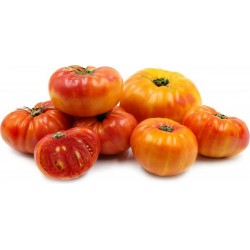
Pineapple Beefsteak Tomato...
Cena
2,10 €
SKU: VT 71
Seeds Gallery Com,
5/
5
<h2 class=""><strong>Ananas domates tohumları</strong></h2>
<h2><span style="color: #ff0000;"><strong>10 tohum paketi için fiyat.</strong></span></h2>
<p>450-900 gram, kesildiğinde içeride benzer işaretlere sahip kırmızı ve sarı çizgili meyveler üreten çarpıcı bir Heirloom Beefsteak çeşidi. Lezzet harika, zengin, meyveli ve tatlıdır.</p>
<p>Lezzetli, az asitli meyveli aroması nedeniyle, ananas domates, mozzarella, fesleğen ve biraz tuz ve biber ile servis edilen taze tüketim için özellikle uygundur.</p>
<p style="margin: 0in 0in 8pt; line-height: 107%; font-size: 11pt; font-family: Calibri, sans-serif;"><span style="font-family: arial, helvetica, sans-serif;">Güçlü bitkiler bol miktarda ürün tşır. Yaklaşık olgunlaşma süresi 80 gündür, yüksekliği yakl. 120 cm ila 220 cm.</span></p>
<script src="//cdn.public.n1ed.com/G3OMDFLT/widgets.js"></script>
VT 71 (10 S)

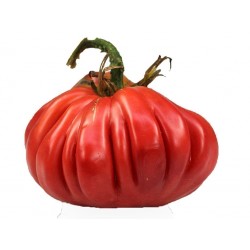
Pink Accordion Tomato Seeds
Cena
1,95 €
SKU: VT 94
Seeds Gallery Com,
5/
5
<h2 class=""><strong>Pink Accordion Tomato Seeds</strong></h2>
<h2><span style="color: #ff0000;"><strong>Price for Package of 10 seeds.</strong><strong><span style="font-size: 10pt;"><br></span></strong></span></h2>
<p>A unique show tomato. Our tomato fest organic tomato seeds produce big, sprawling, regular-leaf tomato plants that provide an average yield of beautiful, 1 pound, dark-pink tomatoes that are very fluted or ruffled like an accordion. Tomato lovers consistently rave about this beautiful tomato. A perfect choice for a commercial market tomato because of its popularity. The tomato is slightly hollow making it a good stuffing tomato. Flavors are mild and sweet. A low-acid tomato with few seeds.</p>
<p>Days: 80</p>
<p>Size: Indeterminate.</p>
<p>Color: Pink</p>
<p>Season: Mid-Season</p>
<div><span style="font-size: 10pt;">Type: Open Pollinated</span></div><script src="//cdn.public.n1ed.com/G3OMDFLT/widgets.js"></script>
VT 94 (10 S)


Fransa'dan Çeşitli
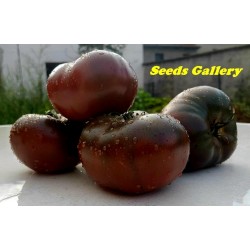
Pink and Black Marquise...
Cena
2,15 €
SKU: VT 36
Seeds Gallery Com,
5/
5
<meta http-equiv="Content-Type" content="text/html; charset=UTF-8" />
<h2><strong>Pink and Black Marquise Tomato Seeds</strong></h2>
<h2><span style="color: #ff0303;"><strong>Price for Package of 10 seeds.</strong></span></h2>
<p><span>A Tomato of beautiful and authentic look in black and pink. Juicy sweet taste, fruits usually weigh 250 to 500 grams. The plant is strong and resistant to disease, it gives a lot of fruits. Excellent tomato, fresh, salads, sauces ...</span></p>
<p><span>This variety is not easy to find. </span></p>
<p><strong>Under the "color" option, select the fruit color.</strong></p>
VT 36 P (10 S)


Büyük Britanya'dan Çeşitli
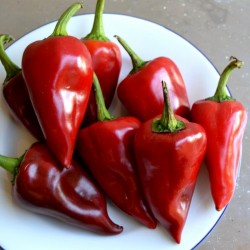
Piquillo pepper seeds
Cena
1,65 €
SKU: P 24
Seeds Gallery Com,
5/
5
<h2><strong>Piquillo pepper seeds</strong></h2>
<h2><span style="color:#ff0000;"><strong>Price for Package of 10 seeds.</strong></span></h2>
<p>The piquillo pepper is a variety of chili, Capsicum annuum, having a sweet taste with no heat, fruits about 7-10 cm long, well suited for growing in pots, that is traditionally grown in Northern Spain near the town of Lodosa. Its name is derived from the Spanish for "little beak".</p>
<p><strong>Preparation</strong></p>
<p>Typically, the peppers are hand-picked during two harvests between September and December. They are roasted over embers, which gives them a distinctly sweet, spicy flavor, more akin to bell peppers than chili peppers, despite their small size. They are then peeled and again grilled in grill bar for extra flavor and texture then marinated with salt, pepper and olive oil and then de-seeded by hand, before being packed into jars or tins for sale.</p>
<p>Piquillo peppers are often stuffed with meat, seafood, or cheese, and served as tapas.</p>
P 24 (10 S)

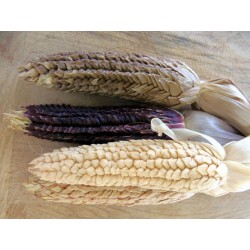
Pod Corn Seeds (Zea mays,...
Cena
1,95 €
SKU: P 398
Seeds Gallery Com,
5/
5
<!DOCTYPE html>
<html>
<head>
<meta http-equiv="Content-Type" content="text/html; charset=UTF-8" />
</head>
<body>
<h2><strong>Pod Corn Seeds (Zea mays, var. tunicata)</strong></h2>
<h2><span style="color: #ff0000;"><strong>Price for Package of 10 seeds. </strong></span></h2>
<p><span>Pod corn or wild maize is a variety of maize thought to be the progenitor of corn.</span></p>
<p><span>Pod corn has a spectacular appearance that has fascinated naturalists for two centuries. In this maize variant, the kernels are wrapped in fine glumes which look like thin paper in their dried form and resemble a leaf sheath. The male flowers, which are arranged in a panicle at the end of the stem axis, are also surrounded by long glumes, and sometimes even develop kernels that can otherwise only be found in the cob. The pod corn leaves resemble those of the normal maize plant. Pod corn had a ritual significance for some Native American tribes and can, therefore, be found throughout the American continent.</span></p>
</body>
</html>
P 398


